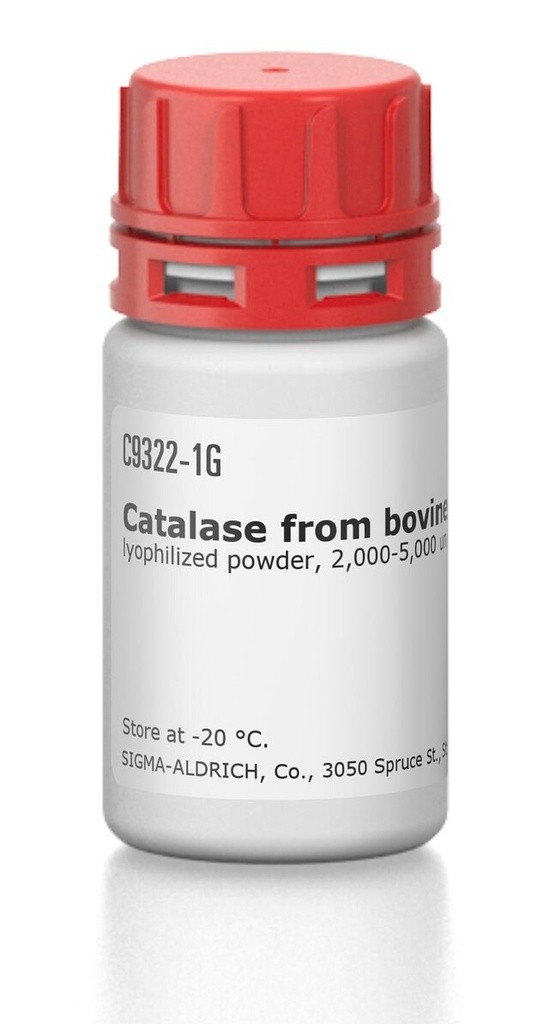Sigma-Aldrich Catalase from bovine liver
Catalog No :
CAS Number :
Brand :
In Stock
powder, suitable for cell culture, 2,000-5,000 units/mg protein
Specifications:
| Application | cell Signalling | ||
| Storage Temperature | -20°C | ||
| Product Type | Enzymes | Forms | lyophilized powder |
| Product Brand | Sigma-Aldrich | ||
| Product Grade | Molecular Biology | ||
Catalase from bovine liver is an antioxidant enzyme that plays a critical role in cellular defense against oxidative damage. It catalyzes the decomposition of hydrogen peroxide (H₂O₂) into water and oxygen, thereby reducing the harmful effects of reactive oxygen species (ROS). The enzyme is a tetrameric protein consisting of four identical subunits, each weighing approximately 60 kDa, and contains iron as a cofactor within a protoheme IX group.
Key Features:
- Structure:
- Tetrameric enzyme with four subunits (60 kDa each).
- Contains iron bound to protoheme IX group.
- NADP is tightly bound within 13.7 angstroms of the heme group.
- Activity and Unit Definition:
- One unit decomposes 1.0 μmole of H₂O₂ per minute at pH 7.0 and 25°C.
- Enzyme activity: 2,000–5,000 units/mg.
- Measured by the decrease in absorbance at 240 nm (A240).
- Solubility:
- Soluble in 50 mM potassium phosphate buffer at a concentration of 1 mg/mL and pH 7.0.
- Stability and Storage:
- Storage Temperature: -20°C for the powdered form.
- Caution: Solutions of catalase should not be frozen, as freezing results in a 50–70% loss of activity.
- Inhibition:
- Inhibited by compounds such as:
- 3-amino-1-H-1,2,4 triazole.
- Cyanide, azide, hydroxylamine, and cyanogen bromide.
- Reducing agents like 2-mercaptoethanol and dithiothreitol.
- Inhibited by compounds such as:
Applications:
- Research Applications:
- Antioxidant Studies: Evaluate the roles of ROS in cellular processes like gene expression and apoptosis.
- Oxidative Stress Studies: Protects proteins, lipids, and nucleic acids from oxidative damage.
- Biocatalysis: Used to catalyze H₂O₂ degradation in biofuel cell development and other enzymatic reactions.
- Industrial Applications:
- Food Industry: Removal of hydrogen peroxide from milk and cheese.
- Textile Industry: Used in textile bleaching processes.
- Bioremediation: Mitigates oxidative stress in DNA-repair mutants of E. coli.
- Specific Use Cases:
- H₂O₂-O₂ Based Biocathodes: Prepare biocathodes for glucose biofuel cells.
- Immobilized Enzyme Studies: Examine kinetic properties and storage stability of catalase immobilized on materials like Florisil.
- Superoxide Generation Research: Utilize in glutathione-mediated superoxide generation in aqueous solutions.
Biochemical Properties:
- Reactivity:
- Catalyzes the conversion of H₂O₂ into H₂O and O₂.
- Reacts with alkylhydrogen peroxides like methylperoxide and ethylperoxide.
- Uses alternate hydrogen donors (e.g., methanol, ethanol, formate).
- Cofactors:
- Requires iron (Fe) or manganese (Mn) as cofactors.
Preparation and Usage Notes:
- Reconstitution:
- Reconstitute in potassium phosphate buffer (pH 7.0) at 1 mg/mL concentration for optimal activity.
- Handling Precautions:
- Avoid freezing reconstituted solutions to maintain enzyme activity.
- Store powdered form at -20°C for long-term stability.
Unit Definition:
- One unit decomposes 1.0 μmole of H₂O₂ per minute at pH 7.0 and 25°C, as measured by the decrease in absorbance at 240 nm.
Storage Recommendations:
- Powder Form: Store at -20°C in a dry environment.
- Reconstituted Solutions: Do not freeze; store at 4°C for short-term use.
Sigma-Aldrich Catalase from bovine liver is a highly versatile enzyme with applications ranging from academic research to industrial processes. Its ability to mitigate oxidative stress makes it invaluable for studying ROS-mediated cellular effects, as well as practical applications in food processing, biofuel technology, and bioremediation efforts.
- Pack Size: 1 Gram 10 Grams




 0
0
